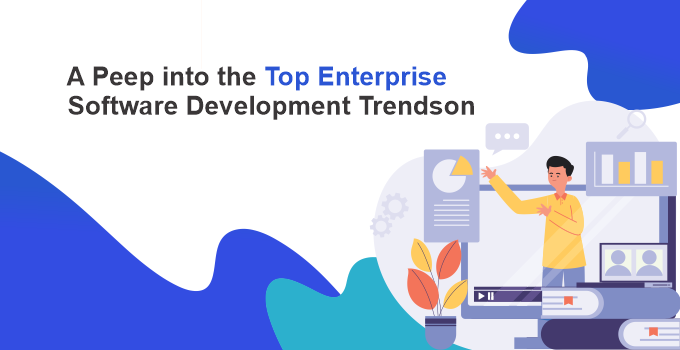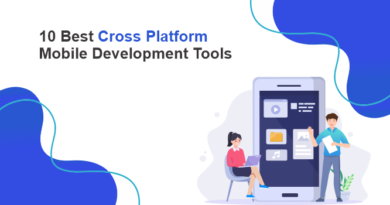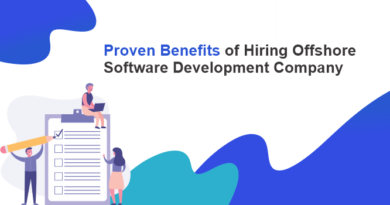A Peep Into the Top 8 2024 Enterprise Software Development Trends
- Software Development Trends in 2024
- Importance of Enterprise Software Development
- The Trend Toward Enterprise Software Development
- 1. Artificial Intelligence (AI)
- 2. Human Augmentation
- 3. Blockchain
- 4. Cloud Computing
- 5. Continuous Integration And Deployment
- 6.Low-code / no-code development
- 7. Big Data
- 8. Native and Progressive Apps
- How to implement trending technologies in developing enterprise solutions?
- Conclusion
The enterprise software development industry is awash with trends-some new, others quite old. One thing never changes, however: the necessity of user experience (UX). Poor UX leads to poor deployment, which will ultimately decrease profitability.
Software Development Trends are rapidly changing now. You will get to know the top 8 enterprise software development trends which will assist you in developing the best software development organization. First of all, let’s know about the history of the enterprise software.
Software Development Trends in 2024
- Artificial Intelligence (AI)
- Human augmentation
- Blockchain
- Cloud computing
- Continuous Integration And Deployment
- Low-code / no-code development
- Big Data
- Native and progressive apps
Importance of Enterprise Software Development
With software at the core of most businesses, it’s important to use reliable software to maintain operations. Without reliable software systems, many businesses could not run efficiently. Software development is the intersection of technology, science, and art. The software produces half the food on Earth and allows people to run millions of processes each day with very little infrastructure
- Work on scalability
- Pay attention to data security
- Find a trusted and reliable partner.
- Have technology that helps in easy maintenance
- Develop a web dashboard for your enterprise operations
- Have an internal testing Programme
- Integrate with the marketing and customer management tools
- Keep controller and backup servers separate
- Have a regular IT audit and report back to you
- Seek consultation from experts when needed
- Have business continuity plans in place before
The Trend Toward Enterprise Software Development
After emerging from the pandemic of 2017, companies have been in a hurry to expand their virtual workforce by training their employees to work remotely. After emerging from the flu pandemic of 2017, companies have been in a hurry to expand their virtual workforce by training their employees to work remotely. And they are hoping to find software to help them achieve that.
Software companies are spending a lot of money to make their websites/applications more prominent in the digital world. And they’re increasingly using apps to do so.
- Platform as a Service
- Serverless
- Software as a Service
All this complexity requires that we add more layers of abstraction, which can be easily done by offering extra help that’s designed to relieve system complexity. Enterprise software development is moving in certain specific directions. Some trends of Enterprise Software Development are:
1. Artificial Intelligence (AI)
Growth in revenue for the AI market is projected to be 12% by the year 2020. A lot of businesses use artificial intelligence solutions to support their operations. They find these solutions to be a real help. Cybersecurity is one of the most important fields in computer science because;
- The software scans for common malicious activity patterns that indicate potential threats to the system.
- IP tracking tools and breach detection software allow you to identify the source of suspicious messages.
When cybersecurity companies engage in AI implementation, their goal is to improve the quality of life and functionality of users. When cybersecurity companies engage in AI implementation, their goal is to improve the quality of life and functionality of users. The most common examples of conversational IT include chatbots and virtual digital assistants.
Click here to read: What is Instagram Threads App? Know Everything
2. Human Augmentation
As time goes on, the extent of how helpful artificial limbs can be is becoming more and more obvious. Considering this, it shouldn’t be surprising to notice that these enhancements are very helpful. Human augmentation involves technologies that enhance human capabilities. VR, AR, and MR are the most popular immersive technologies.
In the last few years, the gaming and video industry has become a lot more lucrative. Virtual Reality has been steadily growing in the past few years, and much of that growth is because of the advancements in technology that allow for more immersive experiences.
VR has already found its way into a variety of industries, e.g. education, communication, and entertainment. VR is already being used by schools and other educational institutions, and they’re finding that VR is making a big difference.
Since corporations exist to serve their customers, they should be excited about the fact that virtual reality can put them in contact with their customers.
Augmented Reality (AR)
The popularity of augmented reality is due to its usefulness across a variety of industries, such as retail, navigation, and manufacturing.
As Facebook and Instagram add more and more augmented reality features, it becomes harder to ignore them. You can’t ignore this trend. The growth of augmented reality is undeniable, and enterprise software development will not be left behind.
Mixed Reality (MR)
The Mixed Reality market is growing rapidly, driven by the desire to provide an all-inclusive and attractive experience to end-users. The market earned $1.054 billion last year, and it will earn $9.982 billion in 2024.
Mixed Reality takes cues from both Augmented Reality and Virtual Reality.
- The user’s view of the real world is enhanced with computer-generated graphics.
- Virtual reality is the creation of an immersive experience is augmented Reality
3. Blockchain
To most people, the word “Blockchain” conjures up images of Bitcoin and the like. Blockchain is a technology that underpins cryptocurrencies such as Bitcoin. It’s a method for creating and distributing digital assets, or tokens, that are fully transferable across the Internet using cryptography. These tokens can be purchased using Bitcoin or other cryptocurrencies and can be used to purchase specific goods and services from third-party stores.
Blockchain technology can offer a solution for
- Many security features
- Transparency
- Decentralization
- A distributed ledger
The most obvious advantages of Blockchain are
- Functional in business
- Blockchain enables the secure, transparent transfer of information regarding products and their manufacturers.
- Prevents the Blockchain from being altered
- Combating censorship and fraud
- No central system
- Encourages community responsibility
4. Cloud Computing
Between 2020 and 2022, some businesses were in the process of transferring their data from on-site servers to cloud servers. As new technologies arise, their impact will be felt across diverse industries. These innovations will change how people do things, which in turn will change the requirements for cloud computing.
The shift to the cloud has become more obvious as data storage is becoming a bigger part of enterprise IT. Cloud platforms are getting more widely used and people’s expectations of them are changing. Technologies that we use to make cloud platforms more robust and secure should also change to accommodate these new expectations.
Cloud Computing is certain to be one of the top enterprise software development trends in 2021.
5. Continuous Integration And Deployment
In an age of massive software updates and DevOps, continuous integration and deployment (CI/CD) can seem like an antique. But it’s today’s most modern software development practices that are putting CI/CD firmly in place as a development method and strategy for building commercially viable applications.
You’ll be able to get feature delivery sooner if you do so in a less detailed manner.
- Continuous delivery is the release of an app through a testing phase.
- Once a new version of an app is available, you’ll be alerted so you can upgrade.
The code testing adds a constant check on product or service quality and acts as a feedback loop for developers. That way, everyone’s taking part in building the product or delivering the service.
6.Low-code / no-code development
Drag-and-drop editors are a breeze to use and can drastically speed up your design process. A lot of the reputation for these kinds of editors is based on the fact that they don’t offer a lot of code options. You don’t need to pick up any coding skills to develop functional apps.
As of 2020, a growing number of apps can rely on tools that produce code automatically. From what I gather, it’s pretty much the same as having software engineers without needing software engineers.
As per forecasts, the market for non-programmers will grow by 28.1% YoY. In 2025, this market is expected to be valued at $ 45.5 billion, significantly higher than the current value of $ 13.2 billion. Low-code platforms are making software easier for end-users to develop.
7. Big Data
Data is a vital source of information about the world. Big data presents your organization with both challenges and opportunities. As data became increasingly powerful, organizations had to become increasingly careful about the data they collected Data and information are key resources for most companies.
However, at present, consumers are being made conscious of the security of their data and how they can be used by companies to sell their goods. Data security is an important consideration for brands to consider if they want to regain customers’ trust.
Considering this, DaaS has plans to come out in 2021: it will ensure that businesses have access to precisely what the users need.
8. Native and Progressive Apps
Native apps for smartphones have been, are now, and will continue to be one of the top trends in enterprise software development. The idea here is to create cross-platform mobile experiences that will engage users and be much easier to maintain.
If you want to build a PWA, you’ll have to make sure you hire a web app development company that’s familiar with the process. The fact that Google prefers PWAs over native apps shows that they bring a lot of benefits to users and developers.
- Native Apps are the best choice for businesses that require in-depth data and analytics
- Progressive Apps are a great option for businesses that are selling products or services remotely or which require real-time customer communication (chat service, e-mail, push notifications, etc.)
- Progressive Apps are the optimum choice for businesses that have to connect both desktop and mobile platforms
- Native apps are better for multitasking
- Progressive apps are easier to maintain and update
For small-time app developers who want to make big apps, stop using the old way and want to know how to make a great Progressive App for your fanbase.
How to implement trending technologies in developing enterprise solutions?
If you want to successfully implement top software trends in enterprise software, the best thing to do is customize your approach. The strategy they’re following is based on a well-thought-out blueprint.
Step 1: Discovery
The last step before the project starts is for your enterprise software development company to meet with your R&D experts and BAs to verify what you have already agreed on and to agree on the final plan.
- Do some basic research to find out how are you doing compared to your competitors.
- Survey competition within your industry.
- It’s crucial to know if your product is commercially viable or not.
- Make it easier for your team to spot bottlenecks.
- Settle upon the right technology stack.
- You need to find the perfect trends if you want your product to be a success.
Step2: Make user personas
To get a clear idea of your target audience, you should create personas, a set of archetypal users that reflect the different types of people who will use your product.
Low fidelity sketches are useful for getting feedback while reflecting on the positive features and working on the negative ones. It’s possible to create sketches and prototypes at much higher fidelity than before.
A detailed, step-by-step approach to a project ensures that the project is completed in a manageable, time-boxed way. It’s important to make sure your message is consistent, so customers will get the same experience no matter which device they use.
Step 3: Development
Once the user experience is designed and the development team is ready, the final step is to create a beta version of the software. The goal is to make a secure code base that will be capable of enduring security breaches.
Agile software development methodologies enabled developers to focus on a singular product, rather than a single phase.
Step 4: Testing
At the end of the development cycle, you need to test your app. Consider this step extremely important in creating a glitch-free app. There are four kinds of testing;
- Through byte-level analysis
- Through statistical evaluation
- Automatically through the Google webmaster application programming interface.
- Manual testing
Step 5: Conclusive Deployment
A task list is a plan that is clear, transparent, and organized. This is why we work with a proven team of developers to deploy and integrate our servers correctly. What may happen if something goes wrong? We have two plans in place:
- A contingency plan
- An alternative approach
Conclusion
Software development is rapidly growing in importance with businesses from all sectors turning their attention towards developing innovative applications that can help them succeed in their day-to-day business activities.
It’s your time to get toward these software development trends. The last thing you want is for your software to be left behind as companies and consumers shift to more smartphone-powered applications and cloud software platforms.



